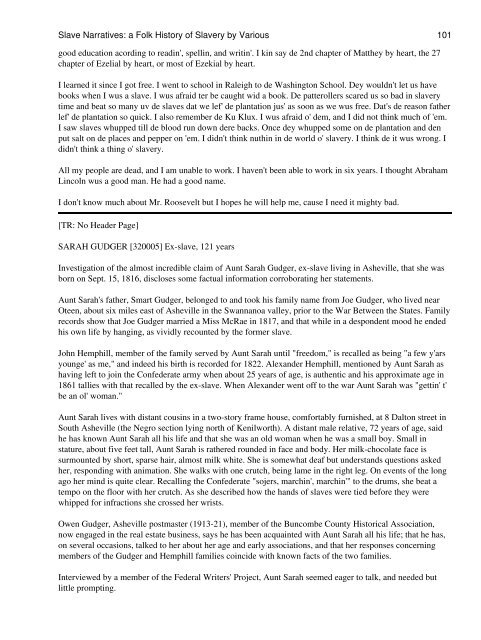Slave Narratives: a Folk History of Slavery in the United States
Slave Narratives: a Folk History of Slavery in the United States
Slave Narratives: a Folk History of Slavery in the United States
You also want an ePaper? Increase the reach of your titles
YUMPU automatically turns print PDFs into web optimized ePapers that Google loves.
<strong>Slave</strong> <strong>Narratives</strong>: a <strong>Folk</strong> <strong>History</strong> <strong>of</strong> <strong>Slave</strong>ry by Various 101good education acord<strong>in</strong>g to read<strong>in</strong>', spell<strong>in</strong>, and writ<strong>in</strong>'. I k<strong>in</strong> say de 2nd chapter <strong>of</strong> Mat<strong>the</strong>y by heart, <strong>the</strong> 27chapter <strong>of</strong> Ezelial by heart, or most <strong>of</strong> Ezekial by heart.I learned it s<strong>in</strong>ce I got free. I went to school <strong>in</strong> Raleigh to de Wash<strong>in</strong>gton School. Dey wouldn't let us havebooks when I wus a slave. I wus afraid ter be caught wid a book. De patterollers scared us so bad <strong>in</strong> slaverytime and beat so many uv de slaves dat we lef' de plantation jus' as soon as we wus free. Dat's de reason fa<strong>the</strong>rlef' de plantation so quick. I also remember de Ku Klux. I wus afraid o' dem, and I did not th<strong>in</strong>k much <strong>of</strong> 'em.I saw slaves whupped till de blood run down dere backs. Once dey whupped some on de plantation and denput salt on de places and pepper on 'em. I didn't th<strong>in</strong>k nuth<strong>in</strong> <strong>in</strong> de world o' slavery. I th<strong>in</strong>k de it wus wrong. Ididn't th<strong>in</strong>k a th<strong>in</strong>g o' slavery.All my people are dead, and I am unable to work. I haven't been able to work <strong>in</strong> six years. I thought AbrahamL<strong>in</strong>coln wus a good man. He had a good name.I don't know much about Mr. Roosevelt but I hopes he will help me, cause I need it mighty bad.[TR: No Header Page]SARAH GUDGER [320005] Ex-slave, 121 yearsInvestigation <strong>of</strong> <strong>the</strong> almost <strong>in</strong>credible claim <strong>of</strong> Aunt Sarah Gudger, ex-slave liv<strong>in</strong>g <strong>in</strong> Asheville, that she wasborn on Sept. 15, 1816, discloses some factual <strong>in</strong>formation corroborat<strong>in</strong>g her statements.Aunt Sarah's fa<strong>the</strong>r, Smart Gudger, belonged to and took his family name from Joe Gudger, who lived nearOteen, about six miles east <strong>of</strong> Asheville <strong>in</strong> <strong>the</strong> Swannanoa valley, prior to <strong>the</strong> War Between <strong>the</strong> <strong>States</strong>. Familyrecords show that Joe Gudger married a Miss McRae <strong>in</strong> 1817, and that while <strong>in</strong> a despondent mood he endedhis own life by hang<strong>in</strong>g, as vividly recounted by <strong>the</strong> former slave.John Hemphill, member <strong>of</strong> <strong>the</strong> family served by Aunt Sarah until "freedom," is recalled as be<strong>in</strong>g "a few y'arsyounge' as me," and <strong>in</strong>deed his birth is recorded for 1822. Alexander Hemphill, mentioned by Aunt Sarah ashav<strong>in</strong>g left to jo<strong>in</strong> <strong>the</strong> Confederate army when about 25 years <strong>of</strong> age, is au<strong>the</strong>ntic and his approximate age <strong>in</strong>1861 tallies with that recalled by <strong>the</strong> ex-slave. When Alexander went <strong>of</strong>f to <strong>the</strong> war Aunt Sarah was "gett<strong>in</strong>' t'be an ol' woman."Aunt Sarah lives with distant cous<strong>in</strong>s <strong>in</strong> a two-story frame house, comfortably furnished, at 8 Dalton street <strong>in</strong>South Asheville (<strong>the</strong> Negro section ly<strong>in</strong>g north <strong>of</strong> Kenilworth). A distant male relative, 72 years <strong>of</strong> age, saidhe has known Aunt Sarah all his life and that she was an old woman when he was a small boy. Small <strong>in</strong>stature, about five feet tall, Aunt Sarah is ra<strong>the</strong>red rounded <strong>in</strong> face and body. Her milk-chocolate face issurmounted by short, sparse hair, almost milk white. She is somewhat deaf but understands questions askedher, respond<strong>in</strong>g with animation. She walks with one crutch, be<strong>in</strong>g lame <strong>in</strong> <strong>the</strong> right leg. On events <strong>of</strong> <strong>the</strong> longago her m<strong>in</strong>d is quite clear. Recall<strong>in</strong>g <strong>the</strong> Confederate "sojers, march<strong>in</strong>', march<strong>in</strong>'" to <strong>the</strong> drums, she beat atempo on <strong>the</strong> floor with her crutch. As she described how <strong>the</strong> hands <strong>of</strong> slaves were tied before <strong>the</strong>y werewhipped for <strong>in</strong>fractions she crossed her wrists.Owen Gudger, Asheville postmaster (1913-21), member <strong>of</strong> <strong>the</strong> Buncombe County Historical Association,now engaged <strong>in</strong> <strong>the</strong> real estate bus<strong>in</strong>ess, says he has been acqua<strong>in</strong>ted with Aunt Sarah all his life; that he has,on several occasions, talked to her about her age and early associations, and that her responses concern<strong>in</strong>gmembers <strong>of</strong> <strong>the</strong> Gudger and Hemphill families co<strong>in</strong>cide with known facts <strong>of</strong> <strong>the</strong> two families.Interviewed by a member <strong>of</strong> <strong>the</strong> Federal Writers' Project, Aunt Sarah seemed eager to talk, and needed butlittle prompt<strong>in</strong>g.
















